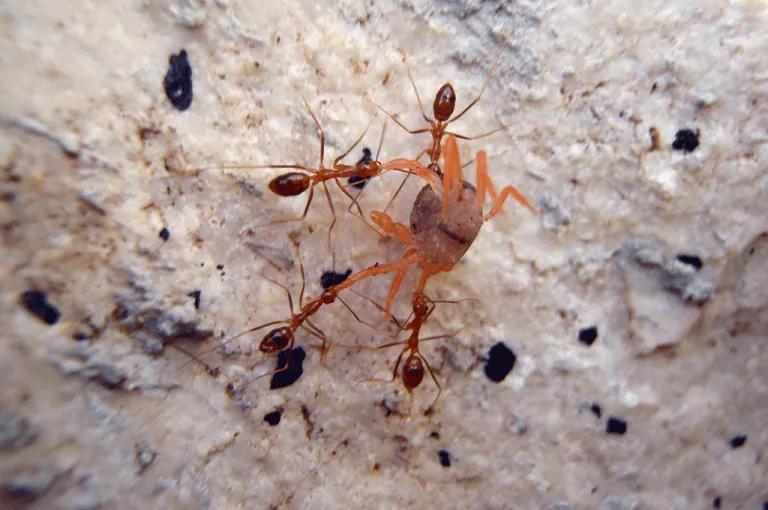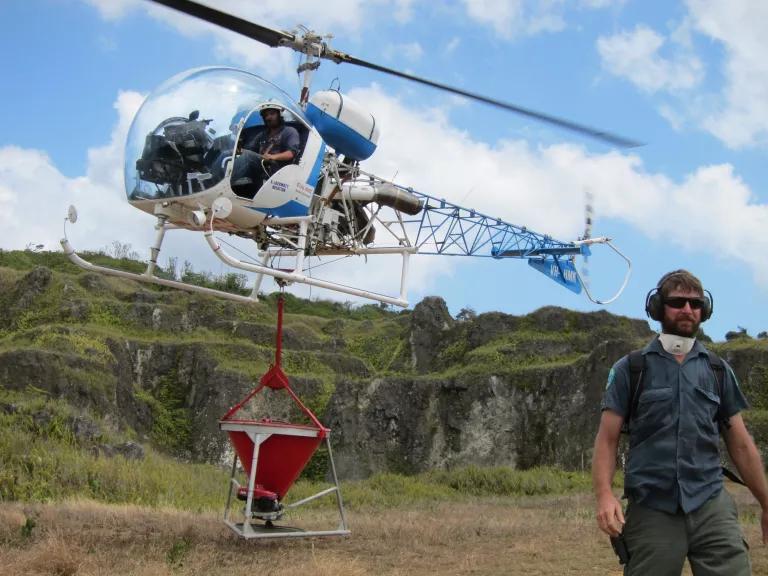The Christmas Crab Massacre
Ants are killing Christmas Island’s iconic red crabs by the millions. Could tiny wasps save the day?

A Christmas Island red crab, Gecarcoidea natalis
budak/Flickr
Named for the day it was discovered in 1643 and located a few hundred miles south of Indonesia, Christmas Island is home to around 45 million red crabs. Every year, these charismatic crustaceans—each about the size of your fist—crawl all over the 52-square-mile island and head to sea en masse to spawn. (This year’s migration began in early December.) People fly in from around the world to witness what resembles armies of cherry Christmas bulbs on the march.
It would seem no force could harry such a legion, armed as it is with claws and chitin. And yet, the crabs have a formidable enemy.
“One of the saddest sights to see on Christmas Island is a sea of dead red crabs on the forest floor,” says Dion Maple, natural resource manager for Christmas Island National Park. “You are looking at literally hundreds of thousands of dead and dying animals. It’s clear that the ecosystem is out of sync in these areas.”
What could possibly kill all those crabs? Crazy ants.
Sometime between 1915 and 1934, humans accidentally introduced yellow crazy ants to the island, an Australian territory in the Indian Ocean. By the 1990s, the ants started forming vast super-colonies with millions of workers and thousands of queens. According to Maple, one super-colony found in 2002 covered nearly 1,900 acres. Scientists call the crazies “unicolonial,” meaning their colonies do not attack each other. Everything else that moves is fair game, though, and on Christmas Island, that means a lots of crabs.

Research conducted by scientists at La Trobe University in Melbourne, Australia, suggests that since the 1990s, the ants have killed tens of millions of crabs, and this has sent shock waves through the island’s ecosystem.
Red crabs eat leaf litter. A forest inhabited by the crustaceans looks like a well-kept parlor, with nary a twig or sprig out of place. But when yellow crazy ants move in, they swarm over the crabs, spraying the crustacean’s eyestalks and leg joints with formic acid. This blinds and immobilizes the crabs, dooming them to death by dehydration—or worse, being torn limb from limb by the ants’ pincers.
Without the crabs, leaf litter builds up, creating a dense mat on the forest floor. Seedlings and saplings take root. Within a matter of months, what was once a sparse understory turns into a thicket of new growth. Dirt tunnels the crabs once maintained eventually collapse, removing hideaway habitat for other creatures. Soil that was tilled by the crabs’ busywork gets compacted. Worst of all, biodiversity plummets as the forest becomes “devoid of life other than that of the crazy ants,” says Maple.
And that’s just at ground level. To understand the true impact of the crazy ants’ reign, you have to look up.

You see, yellow crazy ants can’t form super-colonies without an enormous and steady supply of resources. And one way to ensure this is to ally your army with another insect, one that happens to squirt liquid gold out of its butt—er, abdomen.
Yellow lac scale insects are armored, immobile tree parasites that are also not native to Christmas Island. Like tiny vampires, they anchor themselves to a tree branch and suck out sap, eventually emitting a sugary-sweet waste product called honeydew that the crazies go, well, crazy for.
Honeydew provides the ants with a steady source of carbohydrates and helps their colonies swell to the size of small cities. (The crazy-big colony mentioned above would be about four times the size of downtown Pittsburgh.) In return, the ants protect the scale insects by cleansing the habitat of predators, enabling the parasites to proliferate. Maple says that too many scales can have dire consequences for even the largest of forest trees. “Hundreds of thousands of scale insects can stress the tree to the point where it defoliates. Over multiple seasons this ongoing and relentless stress can kill it.”
Sometimes trees are covered in so many scales that ants can’t collect all of the honeydew being produced. The excess falls onto the leaves of lower branches, encouraging the growth of a fungus called sooty mold. This fungus can hinder a tree’s ability to photosynthesize and eventually cause its death.

Recognizing the havoc wrought by the crazy ants and their cohorts, officials at Christmas Island National Park initiated a targeted poison program starting in the 1990s. The preferred neurotoxin, AntOff, has proved to be effective at controlling the scourge of crazies, but it comes with many drawbacks.
To start, it’s incredibly labor intensive to deploy, given the island’s remote terrain. For many areas, a helicopter must be used to drop death-dealing AntOff from above.
Another issue is that the insecticide is lethal for the island’s 20 species of crabs and many other invertebrate species. To get around this, the park applies the poison only in the dry season, when most crabs are hiding in their burrows. Larger (and exponentially more gnarly) robber crabs can weather dry spells better than their smaller cousins, however, so they often have to be removed from target areas by hand. (And who wants to volunteer for that job? Just look at these things.)
Finally, park officials use the poison only if an ant colony has reached super-colony status. A super-colony is not biodiverse, so any edible poison administered is apt to be monopolized by ants only, leaving little chance that a nontarget species will consume some, too. But there will always be smaller colonies where poison can’t be applied, which means there will always be yellow crazy ants to replace the ones killed.
“It’s clear that chemical control has slowed the decline of the red crab population, but it is not a realistic long-term solution for this ecological calamity,” says Maple. And that may be OK, as it seems the best bet for combating the gruesome twosome might just come from nature itself.

Tachardiaephagus somervillei is a parasitic micro-wasp that’s about one tenth the size of its scientific name. In Malaysia, where yellow lac scale insects are native, T. somervillei keeps the tree parasite in check by laying eggs inside female scales. When baby wasps hatch, they eat the scales from the inside out. Over its lifetime, a single micro-wasp can parasitize more than 150 tree scales, laying up to eight eggs in each. T. somervillei does such a good job that as much as 90 percent of the scales in Malaysia show evidence of parasitization, and they’re considered relatively rare. As a bonus, the wasps consume honeydew, too. So long sooty mold!
T. somervillei was introduced to Christmas Island at some point, but in quantities too few to make a dent in the scale population. So, in 2009, La Trobe University researchers started looking into what impacts the nonnative wasps might have on the island’s ecosystem if they were released there in large numbers. Since then, they’ve found that the wasps could control the scales—and thus the ants—without disrupting other wildlife. (In one study where yellow crazies were deprived of their precious honeydew, ant colony density declined by around 80 percent in just a few weeks.) Government approval for the importation of the wasps is expected next year.
To be clear, no one expects to fully eradicate the ant or the scale, but Maple says the effort just might “put the distorted ecology of Christmas Island back in balance.” And beyond ants and scales, a sturdier ecosystem could better defend itself against other invasive nuisances like rats, centipedes, wolf snakes, and giant African land snails.
According to the Chinese calendar, 2016 is the year of the monkey. On Christmas Island, it may well be the year of the wasp.
This article was originally published on onEarth, which is no longer in publication. onEarth was founded in 1979 as the Amicus Journal, an independent magazine of thought and opinion on the environment. All opinions expressed are those of the authors and do not necessarily reflect the policies or positions of NRDC. This article is available for online republication by news media outlets or nonprofits under these conditions: The writer(s) must be credited with a byline; you must note prominently that the article was originally published by NRDC.org and link to the original; the article cannot be edited (beyond simple things such grammar); you can’t resell the article in any form or grant republishing rights to other outlets; you can’t republish our material wholesale or automatically—you need to select articles individually; you can’t republish the photos or graphics on our site without specific permission; you should drop us a note to let us know when you’ve used one of our articles.

These 5 Animals Would Be Goners Without the Endangered Species Act
Finally, a High Seas Treaty to Protect the World’s Oceans
Can Anything Be Done to Stop Overfishing?